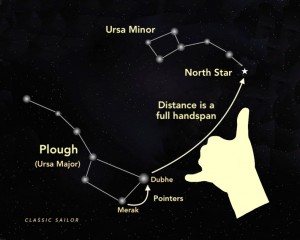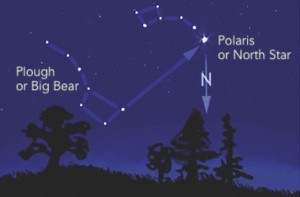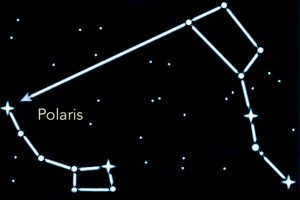Chasing stars
Night Sailing offshore is easier if you pick a star to follow rather than constantly squinting at the compass. But be aware that the star is always moving across the sky.
Seeing as how Penny was new to sailing, let alone sailing across the Channel and south to St Malo at night, I thought I’d offer a tip on steering by compass. “You don’t need to keep watching that,” I offered confidently. “Just find a star and keep her head on that; it’s easier to keep your bearings – I’m just going below.”
I was trying to make it easier for her because she had been chasing the compass at times. Chasing the compass is less common with a tiller-steered boat than with a wheel. Novice helmspeople sometimes stare hard at the compass card and as it swings around, showing the ship to be going off course, it seems natural to follow or chase the swing rather than going to meet it to correct the course. Of course the compass swings more and before you know it you have flapping sails or worse still a gybe. Tiller steering instinctively seems to prevent this, but not always… and this was just about Penny’s first sail.
She was probably tired from a cross Channel passage and a boisterous F5 early evening beat through Little and Great Russell between Guernsey, Herm and Sark and now we were halfway through the first watch and had come off the wind a point to miss the Minquiers Reef and close the coast with St Malo. It was a perfect night, with around ten knots of southwesterly breeze and an easy latent western swell.
Shipmen have steered by a star at night since man’s earliest times afloat. Stars tend to rise in the same place each night (with few exceptions) and follow an east to west course across the night sky as the world turns. Regardless of the time of sunset or sunrise, stars rise four minutes earlier each night.
So if you look to the east the early evening stars are slightly higher in the sky with each passing night. Some stars are like friends to a sailor and the best known in the northern hemisphere is Polaris or the North Star, which is always within a degree of true north, and its leading stars the two ‘pointers’ of Dubhe and Merak at the end of the Plough (or Big Dipper in America and Canada).
It’s easy to find the North Star if we follow the transit of these two pointers and a hand’s breadth (with our arm outstretched) above them we’ll always find Polaris; the distance to Polaris is five times the distance between the two pointers. Steer with Polaris on the bow and you are sailing north, steer with her on your port beam and you are sailing east and so on.
After a while at sea on clear nights you get a sense of the stars and their well-known patterns and a certain instinct takes over for steering on a star. It’s comfortable to be at the helm and pick a star in front of you, usually between the windward shrouds and the mast; helming becomes second nature and the boat sails more smoothly. Every few minutes you can check the compass for accuracy of your course but you do have to be aware the stars are wheeling overhead.

To find Polaris follow the line of the Plough’s pointers holding your open handspan in front of you at arm’s length
If you are steering east or west you can follow the same stars for an hour or more, they just slide slowly up from or down to the horizon in front of you. If you are sailing north on Polaris you can use that but in high latitudes (of the northern hemisphere) its declination, (angle from the horizon) is also very high, so it can feel like looking straight above the mast truck and is therefore less easy to use as a star to steer by.
Sailing south on a star is altogether more tricky – until you get south enough to use the southern hemisphere’s equivalent to Polaris – the Southern Cross. The earth is rotating eastabout at 15º an hour, so I shouldn’t have been surprised when flapping sails and a wallowing motion brought me out on deck to find Penny believing the wind had changed. She had faithfully followed our chosen star as it tracked off to the west and it had gradually brought the boat from her fine reach, up into the wind. My fault for, ah, staying below so long… DH
Main picture: This 10 minute exposure aimed at the Pole Star shows the movement of stars around it.
Inset: To find Polaris follow the Plough’s pointers holding your open handspan at arm’s length in front of you
For some history of sailing by a star visit: HERE




